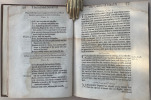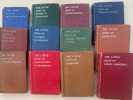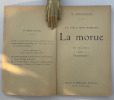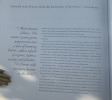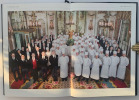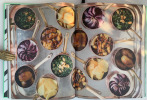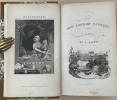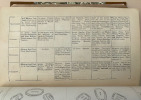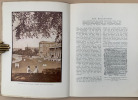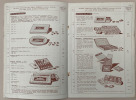les diners de Gala
translated by Captain J. Peter Moore FELICIE, INC.- PUBLISHERS - NEW YORK
1st EDITION. 1973. Thick 4to. 350 x 220 x 35 mm. Inside cover and first page with Illustration of bread and signed by an indistinctly named husband to his wife. [2] Frontis of Dali. Title Page. 8 - 316. 317 - 321 Table of Contents. [1] A dedication page for the origins of the book's recipes. 1 fep and inside end cover with a fantastic illustration of 4 nude women dining. Hardcover with bright gold, foil-like wildly illustrated dust jacket. Overall, exceptionally fine condition. Also inserted inside is a fine lithograph of an apple and leaves in colour. Being a Dali creation, it is not just an apple, but has a quickly done line drawing of a guitarist in a landscape. Numbered 181/250. With Dali's distinct signature in pencil.
- This production by the great Spanish Surrealist painter Salvador Dali, has to be defined as one of the most interesting and unusual cookery books ever published, with recipes by the Chefs of famous Paris restaurants, such as Lasserre, La Tour d’Argent, Maxim’s, and Le Train Bleu (Le Buffet de la Gare de Lyon). The chapters are as follows: 1 Les caprices pincés princiers exotic dishes: 2 Les cannibalismes de l'automne eggs - sea food: 3 Les suprêmes de malaises lilliputiens first course: 4 Les entre-plats sodomisés meals: 5 Les spoutniks astiqués d'asticots statistiques snails - frogs: 6 Les panaches panachés fish - shell fish: 7 Les chairs monarchiques game - poultry: 8 Les montres molles 1/2 sommeil pork: 9 L'atavisme désoxyribonucléique vegetables: 10 Les "je mange GALA" aphrodisiacs: 11 Les pios nonoches sweets - dessert: 12 Les délices petits matryrs hors-d'œuvre: It is also an outstanding art book that not only has very good recipes, but is a wonder to read. Dali also notes in the introduction that his book is not designed for anyone watching their waistline. Born on 11 May 1904, at 8:45 am GMT in Figueres, Catalonia, Salvador Dalí was a skilled artist and draftsman best known for the striking and bizarre images in his work. His painting skills are often attributed to the influence and fine finishing of Renaissance masters. His best-known work, The 'Persistence of Memory', was completed in August 1931, and is one of the most recognisable Surrealist paintings. Dalí's expansive artistic repertoire included film, sculpture, and photography, at times in collaboration with a range of artists in a variety of media. This book of cookery is an unusual addition to his norm. Dalí was highly imaginative, and also enjoyed indulging in unusual and grandiose behaviour. To the dismay of those who held his work in high regard, and to the irritation of his critics, his eccentric manner and attention-grabbing public actions sometimes drew more attention than his artwork. Dalí attended drawing school. In 1916, he also discovered modern painting on a summer vacation trip to Cadaqués with the family of Ramon Pichot, a local artist who made regular trips to Paris. The next year, Dalí's father organized an exhibition of his son's charcoal drawings in their family home. He had his first public exhibition at the Municipal Theatre in Figueres in 1918. In early 1921 the Pichot family introduced Dalí to Futurism and Dalí's uncle Anselm Domenech, who owned a bookshop in Barcelona, supplied him with books and magazines on Cubism and contemporary art. On 6 February 1921, Dalí's mother died of uterine cancer. Dalí was 16 years old; he later said his mother's death "was the greatest blow I had experienced in my life. I worshipped her... I could not resign myself to the loss of a being on whom I counted to make invisible the unavoidable blemishes of my soul. After her death, Dalí's father married his deceased wife's sister. Dalí did not resent this marriage, because he had great love and respect for his aunt. In 1929, Dalí collaborated with the surrealist film director Luis Buñuel on the short film 'Un Chien Andalou' (An Andalusian Dog). His main contribution was to help Buñuel write the script for the film. Dalí later claimed to have also played a significant role in the filming of the project, but this is not substantiated by contemporary accounts. Also, in August 1929, Dalí met his lifelong and primary muse and future wife Gala, born Elena Ivanovna Diakonova. She was a Russian immigrant ten years his senior, who at that time was married to surrealist poet Paul Éluard. In the same year, Dalí officially joined the Surrealist group in the Montparnasse quarter of Paris. The Surrealists hailed what Dalí called his paranoiac-critical method of accessing the subconscious for greater artistic creativity. Gala first met Dalí that year during a trip to Cadaques with her family and the artist Magritte and his wife. Despite the ten-year age gap, the love affair between Dalí and Gala quickly developed. In 1948 Dalí and Gala moved back into their house in Port Lligat, on the coast near Cadaqués. For the next three decades, he would spend most of his time there painting, taking time off and spending winters with his wife in Paris and New York. Gala died on 10 June 1982, at the age of 87. After Gala's death, Dalí lost much of his will to live. He deliberately dehydrated himself. On the morning of 23 January 1989, while his favourite record of Tristan and Isolde played, Dalí died of heart failure at the age of 84. He is buried in the crypt below the stage of his Theatre and Museum in Figueres. The location is across the street from the church of Sant Pere, where he had his baptism, first communion, and funeral, and is only 450 metres from the house where he was born. An amazing unparalleled life. This book and lithograph, a fantastic insight and glimpse of the great artist. Only around 400 copies of Les Diners de Gala are known to survive. However, Taschen has finally published and made this rare book available for the first time in 43 years as a new reprinted 2nd edition.






click on image to enlarge

Modern category
ref number:
11252 




